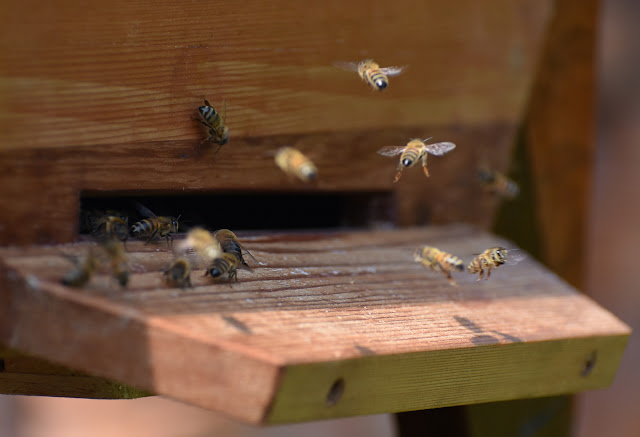Joining the Local Beekeepers Association proved to be the answer that enabled me to retrieve my first swarm. Word came through of a swarm high in a Cotoneaster bush situated in the back garden of a house in Kingsteignton.
 |
South facing in the morning sun |
Sunday was warm and quite humid, with a good weather forecast for the coming week. Bees obviously choose the weather carefully before making their move to a new home.
Andrew and me arrived at about 7pm. equipped with sugar water sprayer, bee suits and smoker, plus a cardboard box and ground sheets. Fortunately the lady whose garden we were about to enter had a ladder and steps which enabled us to reach up high. We clipped back the vegetation immediately beneath the swarm before I went up the steps holding open the cardboard box, while Andrew climbed the ladder to almost level with the swarm which was swaying slightly, the shape of a rugby ball, and only just a little smaller. It was dislodged with the first vigorous shake of the branch and dropped squarely into the box right above my head.
The box was held up there for almost ten minutes, while the air borne remainder of the swarm decided to follow into the box, attracted by their brothers and sisters plus the queen which was not seen but judged to have fallen in, by the way the bees remained quietly in the box.
It was lowered to the ground and carefully taped shut. Later the same evening we met closer to home and off loaded the bees into my newly prepared hive. All went remarkably smoothly. The smoker was on stand-by but not required. Andrew's sprayer of sugar water was deployed briefly, but barely necessary as the bees seemed remarkably docile.
 |
Activity at 8.15am Monday |
My guess at the number above is only a guess but by the time they establish a full colony into next spring I am hoping I shall be the keeper of at least fifty thousand, having a hive that will easily accommodate that number by opening up to its full extent. For the time being and until the colony has its own honey stores supplementary food is to be given by way syrup 50/50 sugar/water. There is so much to understand and consider that success or failure to help them survive next winter will be quite a challenge.
Tuesday is a hot 29 deg C and the bees are busy entering and exiting at about 30 per minute. Some are returning with pollen which is a good sign. Later this afternoon 60 per minute are entering.
 |
Pollen being collected |
 |
About 60 per minute seen entering at this time |
 |
The entrance being larger than required is to be restricted with a 1/2 high plug come mouse guard. |
 |
By the second day of occupation the bees have established their shortest route from the landing platform to the colony cluster inside which is up in the left side corner farthes from the entrance. |
Wednesday just three days after occupying the hive, more pollen is being gathered and by peering through the side window there is seen to be comb formed down off the top bars. Due to the high density of bees working, only one comb was visible but others may be flanking either side of this.
 |
The entrance in need of reducing - The left side in use much more so than the right side. |


No comments:
Post a Comment